Integration of Geophysical and Geospatial Techniques to Evaluate Geothermal Energy at Siwa Oasis, Western Desert, Egypt
Abstract
:1. Introduction
2. Geothermal Regime in Egypt
3. Geological Setting
4. Materials and Methods
4.1. Magnetic Data
4.2. Well Logging Data
4.3. Remote Sensing Data Set and Analysis
4.3.1. Digital Elevation Model (DEM)
4.3.2. Thermal Infrared Data
4.4. Geological Units Layer
4.5. GIS-Based Geothermal Potential Model
5. Results
Potential Locations for Geothermal Exploration
6. Discussion
7. Conclusions
Author Contributions
Funding
Data Availability Statement
Acknowledgments
Conflicts of Interest
References
- Lashin, A. Review of the Geothermal Resources of Egypt: 2015–2020. In Proceedings of the World Geothermal Congress 2020, Reykjavik, Iceland, 26 April–2 May 2020. [Google Scholar]
- Ahmed, E.A. Assessment of the Geosites and Geodiversity in the Prospective Geopark in Siwa in the Western Desert of Egypt. Int. J. Geoheritage Parks 2023, 11, 182–201. [Google Scholar] [CrossRef]
- Misak, R.F.; Abdel Baki, A.A.; El-Hakim, M.S. On the Causes and Control of the Waterlogging Phenomenon, Siwa Oasis, Northern Western Desert, Egypt. J. Arid. Environ. 1997, 37, 23–32. [Google Scholar] [CrossRef]
- Zaher, M.A.; Senosy, M.M.; Youssef, M.M.; Ehara, S. Thickness Variation of the Sedimentary Cover in the South Western Desert of Egypt as Deduced from Bouguer Gravity and Drill-Hole Data Using Neural Network Method. Earth Planet. Space 2009, 61, 659–674. [Google Scholar] [CrossRef]
- Fahmy, M.; Hossary, M.; Oasis, S. Investigating the Development Challenges to Siwa Oasis, Northwestern Desert, Egypt. N. Y. Sci. J. 2013, 6, 55–61. [Google Scholar]
- Abdulaziz, A.M.; Faid, A.M. Evaluation of the Groundwater Resources Potential of Siwa Oasis Using Three-Dimensional Multilayer Groundwater Flow Model, Mersa Matruh Governorate, Egypt. Arab. J. Geosci. 2015, 8, 659–675. [Google Scholar] [CrossRef]
- Morgan, P.; Black’well, D.D.; Fanis, T.G.; Boulos, F.K.; Salib, P.G. Preliminary Temperature Gradient and Heat Flow Values for Northern Egypt and the Gulf of Suez from Oil Well Data. Proc. Int. Congr. Therm. Waters Geotherm. Energy Volcanism Mediterr. Area Geotherm. Energy 1976, 1, 424–438. [Google Scholar]
- Morgan, P.; Boulos, F.K.; Swanberg, C.A. Regional Geothermal Exploration in Egypt. Geophys. Prospect. 1983, 31, 361–376. [Google Scholar] [CrossRef]
- Morgan, P.; Boulos, F.K.; Hennin, S.F.; El-Sherif, A.A.; El-Sayed, A.A.; Basta, N.Z.; Melek, Y.S. Heat Flow in Eastern Egypt: The Thermal Signature of a Continental Breakup. J. Geodyn. 1985, 4, 107–131. [Google Scholar] [CrossRef]
- Sturchio, N.; Arehart, G.; Sultan, M.; Sano, Y.; Abokamar, Y.; Sayed, M. Composition and Origin of Thermal Waters in the Gulf of Suez Area, Egypt. Appl. Geochem. 1996, 11, 471–479. [Google Scholar] [CrossRef]
- Gad, E.Q.; Ushijima, K.; Ahmad, E.S. Delineation of A Geothermal Reservoir by 2d Inversion of Resistivity Data at Hamam Faraun Area, Sinai, Egypt. In Proceedings of the World Geothermal Congress 2000, Kyushu, Tohoku, Japan, 28 May–10 June 2000. [Google Scholar]
- Abdel Zaher, M.; Saibi, H.; Nouby, M.E.; Ghamry, E.; Ehara, S. A Preliminary Regional Geothermal Assessment of the Gulf of Suez, Egypt. J. Afr. Earth Sci. 2011, 60, 117–132. [Google Scholar] [CrossRef]
- Zaher, M.A.; Saibi, H.; Nishijima, J.; Fujimitsu, Y.; Mesbah, H.; Ehara, S. Exploration and Assessment of the Geothermal Resources in the Hammam Faraun Hot Spring, Sinai Peninsula, Egypt. J. Asian Earth Sci. 2012, 45, 256–267. [Google Scholar] [CrossRef]
- El-Qady, G. Exploration of a Geothermal Reservoir Using Geoelectrical Resistivity Inversion: Case Study at Hammam Mousa, Sinai, Egypt. J. Geophys. Eng. 2006, 3, 114–121. [Google Scholar] [CrossRef]
- Mekkawi, M.; Ebohoty, M. Delineation of Subsurface Structures and Tectonics; Geophysical Research Abstracts; European Geosciences Union: Munich, Germany, 2007; Volume 9, p. 05014. [Google Scholar]
- Atya, M.A.; Khachay, O.A.; Abdel Latif, A.; Khachay, O.Y.; El-Qady, G.M.; Taha, A.I. Geophysical Contribution to Evaluate the Hydrothermal Potentiality in Egypt: Case Study: Hammam Faraun and Abu Swiera, Sinai, Egypt. Earth Sci. Res. J. 2010, 14, 44–62. [Google Scholar]
- Lashin, A. A Preliminary Study on the Potential of the Geothermal Resources around the Gulf of Suez, Egypt. Arab. J. Geosci. 2013, 6, 2807–2828. [Google Scholar] [CrossRef]
- Swanberg, C.A.; Morgan, P.; Boulos, F.K. Geothermal Potential of Egypt. Tectonophysics 1983, 96, 77–94. [Google Scholar] [CrossRef]
- Zein El-Din, M.Y. Subsurface Geothermal Study in the Central Part of the Northern Western Desert, Egypt. Qatar Univ. Sci. Bull. 1983, 3, 207–215. [Google Scholar]
- Mohamed, H.S.; Abdel Zaher, M.; Senosy, M.M.; Saibi, H.; El Nouby, M.; Fairhead, J.D. Correlation of Aerogravity and BHT Data to Develop a Geothermal Gradient Map of the Northern Western Desert of Egypt Using an Artificial Neural Network. Pure Appl. Geophys. 2015, 172, 1585–1597. [Google Scholar] [CrossRef]
- Khalil, A.; All, E.; Rabeh, T.; Osman, S. Integrated Geophysical Study to Delineate the Subsurface Structures in Siwa Oasis, Western Desert, Egypt; NASA: Washington, DC, USA, 2015.
- Zaher, M.A.; Saibi, H.; Mansour, K.; Khalil, A.; Soliman, M. Geothermal Exploration Using Airborne Gravity and Magnetic Data at Siwa Oasis, Western Desert, Egypt. Renew. Sustain. Energy Rev. 2018, 82, 3824–3832. [Google Scholar] [CrossRef]
- Gindy, A.R.; El, A.M. Stratigraphy, Structure, and Origin of Siwa Depression, Western Desert of Egypt. Bulletin 1969, 53, 603–625. [Google Scholar] [CrossRef]
- Continental Oil Company; Squyres, C.H.; Klitzsch, E.; Handley, R.; List, F.K.; Pöhlmann, G.; Hay’ah al-Miṣrīyah al-‘Āmmah lil-Batrūl. Geological Map of Egypt 1:500,000. NH 36 SW, Beni Suef; Conoco: Cairo, Egypt, 1987. [Google Scholar]
- Said, R. The Geology of Egypt, 1st ed.; Said, R., Ed.; Routledge: Oxfordshire, UK, 2017; ISBN 978-0-203-73667-8. [Google Scholar]
- Elshazly, E.M.; Abdel-Hady, M.A.; Elshazly, M.M.; Elghawaby, M.A.; Khawasik, S.M.; Haraga, A.A.; Sanad, S.; Attia, S.H. Application of LANDSAT Imagery in the Geological and Soil Investigations in the Control Western Desert, Egypt. In Earth Resources and Remote Sensing, Proceedings of the International Symposium on Remote Sensing of the Environment, Manila, Philippines, 20 April 1978; NASA: Washington, DC, USA, 1978. [Google Scholar]
- Getech. The African Magnetic Mapping Project–Commercial Report; Paterson Grant & Watson Ltd.: Toronto, ON, Canada, 1992. [Google Scholar]
- Green, C.M.; Barritt, S.D.; Fairhead, J.D.; Misener, D.J. The African Magnetic Mapping Project; Paterson Grant & Watson Ltd.: Toronto, ON, Canada, 1992. [Google Scholar]
- Mendonça, C.A.; Silva, J.B.C. A Stable Truncated Series Approximation of the Reduction-to-the-pole Operator. Geophysics 1993, 58, 1084–1090. [Google Scholar] [CrossRef]
- Pirttijärvi, M. Bloxer Interactive Visualization and Editing Software for 3-D Block Models, Version 1.5, User’s Guide; Geophysical Survey of Finland: Espoo, Finland, 2004. [Google Scholar]
- Ibrahim, S.A. Studies on Groundwater Possibilities in the Northern Part of the Western Desert-Egypt; Cairo University: Cairo, Egypt, 1991. [Google Scholar]
- GPC (the Egyptian General Petroleum Corporation). A Comprehensive Overview, Western Desert, Oil and Gas Fields; EGPC: New Maadi, Cairo, Egypt, 1992; p. 431. [Google Scholar]
- Afifi, A.H. Assessment of the Hydrogeological Conditions of Groundwater in Siwa Oasis, North Western Desert, Egypt; Minufiya University: Al Minufiyah, Egypt, 2005. [Google Scholar]
- Horner, D.R. Pressure Build-Up in Wells. In Proceedings of the World Petroleum Congress (WPC), Hague, The Netherlands, 28 May 1951. Volume All Days. [Google Scholar]
- Waples, D.W.; Pacheco, J.; Vera, A. A Method for Correcting Log-Derived Temperatures in Deep Wells, Calibrated in the Gulf of Mexico. PG 2004, 10, 239–245. [Google Scholar] [CrossRef]
- Lachenbruch, A.H.; Brewer, M.C. Dissipation of the Temperature Effect of Drilling a Well in Arctic Alaska; U.S. Geological Survey: Reston, VI, USA, 1959; Bull, 1083-C; pp. 73–109.
- Ribeiro, F.B.; Hamza, V.M. Stabilization of Bottom-Hole Temperature in the Presence of Formation Fluid Flows. Geophysics 1986, 51, 410–413. [Google Scholar] [CrossRef]
- Shen, P.Y.; Beck, A.E. Stabilization of Bottom Hole Temperature with Finite Circulation Time and Fluid Flow. Geophys. J. Int. 1986, 86, 63–90. [Google Scholar] [CrossRef]
- Dowdle, W.L.; Cobb, W.M. Static Formation Temperature from Well Logs—An Empirical Method. J. Pet. Technol. 1975, 27, 1326–1330. [Google Scholar] [CrossRef]
- Middleton, M.F. A Model for Bottom-hole Temperature Stabilization. Geophysics 1979, 44, 1458–1462. [Google Scholar] [CrossRef]
- Luheshi, M.N. Estimation of Formation Temperatures from Borehole Measurements. Geophys. J. R. Aston. Soc. 1983, 74, 747–776. [Google Scholar]
- Lashin, A.; Arifi, N. Some Aspects of the Geothermal Potential of Egypt: Case Study; Gulf of Suez-Egypt. In Proceedings of the World Geothermal Congress, Bali, Indonesia, 25–29 April 2010. [Google Scholar]
- Burton-Johnson, A.; Dziadek, R.; Martin, C. Review Article: Geothermal Heat Flow in Antarctica: Current and Future Directions. Cryosphere 2020, 14, 3843–3873. [Google Scholar] [CrossRef]
- Tanaka, A.; Okubo, Y.; Matsubayashi, O. Curie Point Depth Based on Spectrum Analysis of the Magnetic Anomaly Data in East and Southeast Asia. Tectonophysics 1999, 306, 461–470. [Google Scholar] [CrossRef]
- Turcotte, D.L.; Schubert, G. Geodynamics, 2nd ed.; Cambridge University Press: Cambridge, UK, 2002; ISBN 978-0-521-66624-4. [Google Scholar]
- Prensky, S. Temperature Measurements in Boreholes: An Overview of Engineering and Scientific Applications. Log. Anal. 1992, 33, 313–333. [Google Scholar]
- O’Leary, D.W.; Friedman, J.D.; Pohn, H.A. Lineament, Linear, Lineation: Some Proposed New Standards for Old Terms. Geol. Soc. Am. Bull. 1976, 87, 1463. [Google Scholar] [CrossRef]
- Abrams, W.; Ghoneim, E.; Shew, R.; LaMaskin, T.; Al-Bloushi, K.; Hussein, S.; AbuBakr, M.; Al-Mulla, E.; Al-Awar, M.; El-Baz, F. Delineation of Groundwater Potential (GWP) in the Northern United Arab Emirates and Oman Using Geospatial Technologies in Conjunction with Simple Additive Weight (SAW), Analytical Hierarchy Process (AHP), and Probabilistic Frequency Ratio (PFR) Techniques. J. Arid. Environ. 2018, 157, 77–96. [Google Scholar] [CrossRef]
- Hanano, M. Two Different Roles of Fractures in Geothermal Development. In Proceedings of the World Geothermal Congress, Kyushu, Tohoku, Japan, 28 May–10 June 2000. [Google Scholar]
- Armandine Les Landes, A.; Guillon, T.; Peter-Borie, M.; Blaisonneau, A.; Rachez, X.; Gentier, S. Locating Geothermal Resources: Insights from 3D Stress and Flow Models at the Upper Rhine Graben Scale. Geofluids 2019, 2019, 8494539. [Google Scholar] [CrossRef]
- Wallis, I.C.; Mcnamara, D.D.; Rowland, J.V.; Massiot, C. The Nature of Fracture Permeability in the Basement Greywacke at Kawerau Geothermal Field, New Zealand. In Proceedings of the Thirty-Seventh Workshop on Geothermal Reservoir Engineering Stanford University, Stanford, CA, USA, 30 January–1 February 2012. [Google Scholar]
- Grindley, G.W. Geology, Structure, and Exploitation of the Wairakei Geothermal Field, Taupo, New Zealand. N. Z. Geol. Surv. Bull. 1965, 75, 5197846. [Google Scholar]
- Hodder, D.T. Application of Remote Sensing to Geothermal Prospecting. Geothermics 1970, 2, 368–380. [Google Scholar] [CrossRef]
- Kienholz, C.; Prakash, A.; Kolker, A. Geothermal Exploration in Akutan, Alaska, Using Multitemporal Thermal Infrared Images. In Proceedings of the AGU Fall Meeting Abstracts, San Francisco, CA, USA, 14–18 December 2009; Volume 2009. H53F-1009. [Google Scholar]
- Fahil, A.S.; Ghoneim, E.; Noweir, M.A.; Masoud, A. Integration of Well Logging and Remote Sensing Data for Detecting Potential Geothermal Sites along the Gulf of Suez, Egypt. Resources 2020, 9, 109. [Google Scholar] [CrossRef]
- Shimron, A.E. Evolution of the Kid Group, Southeast Sinai Peninsula: Thrusts, Melanges, and Implications for Accretionary Tectonics during the Late Proterozoic of the Arabian-Nubian Shield. Geology 1984, 12, 242–247. [Google Scholar] [CrossRef]
- Lashin, A. Geothermal Resources of Egypt: Country Update. In Proceedings of the World Geothermal Congress, Melbourne, Australia, 19–25 April 2015; pp. 1–13. [Google Scholar]
- Tesfa, B. Benefit of Grand Ethiopian Renaissance Dam Project (GERDP) for Sudan and Egypt. EIPSA Commun. Artic. Energy Water Environ. Econ. 2013, 1, 1–12. [Google Scholar]
- Mulat, A.G.; Moges, S. Assessment of the Impact of the Grand Ethiopian Renaissance Dam on the Performance of the High Aswan Dam. J. Water Resour. Prot. 2014, 6, 583–598. [Google Scholar] [CrossRef]
- Zaher, M.A.; Nishijima, J.; Fujimitsu, Y.; Ehara, S.E. Assessment of Low-Temperature Geothermal Resource of Hammam Faraun Hot Spring, Sinai Peninsula, Egypt. In Geothermic SGP-TR-191, Proceedings of the Thirty-Sixth Workshop on Geothermal Reservoir Engineering Stanford University, Stanford, CA, USA, 31 January–2 February 2010; Stanford University: Stanford, CA, USA, 2010. [Google Scholar]
- Available online: https://www.thinkgeoenergy.com (accessed on 13 January 2019).
- Dutiro, L. The Power of the Unknown: Geothermal Energy in Zimbabwe. The Chronicle Published. 11 June 2019. [Google Scholar]
- Annual U.S. & Global Geothermal Power Production Report March 2016. Available online: https://Geothermal.Org/Policy_Committee/Documents/2016_Annual_US_Global_Geothermal_Power_Production.Pdf (accessed on 20 June 2020).
- Abdallah, A. Assessment of Salt Weathering in Siwa Oasis (The Western Desert of Egypt). Bull. Soc. Geogrphie Egypte 2007, 80, 65–80. [Google Scholar]
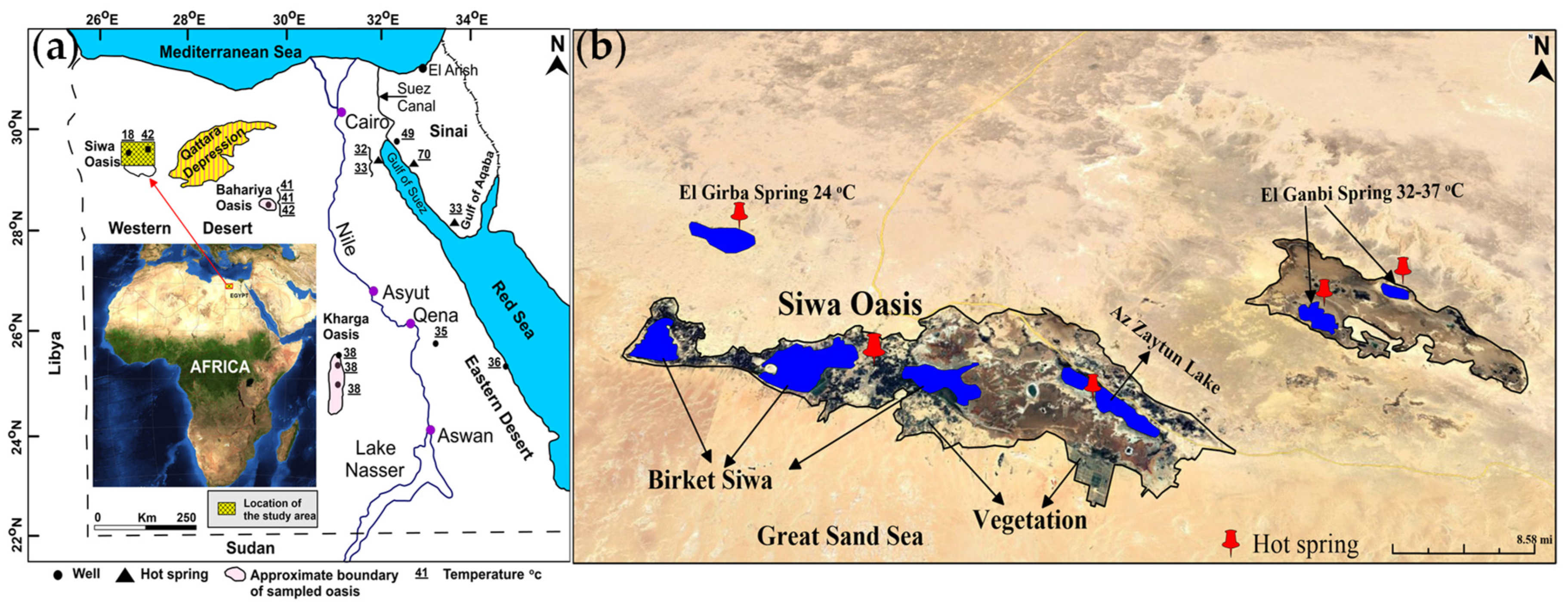
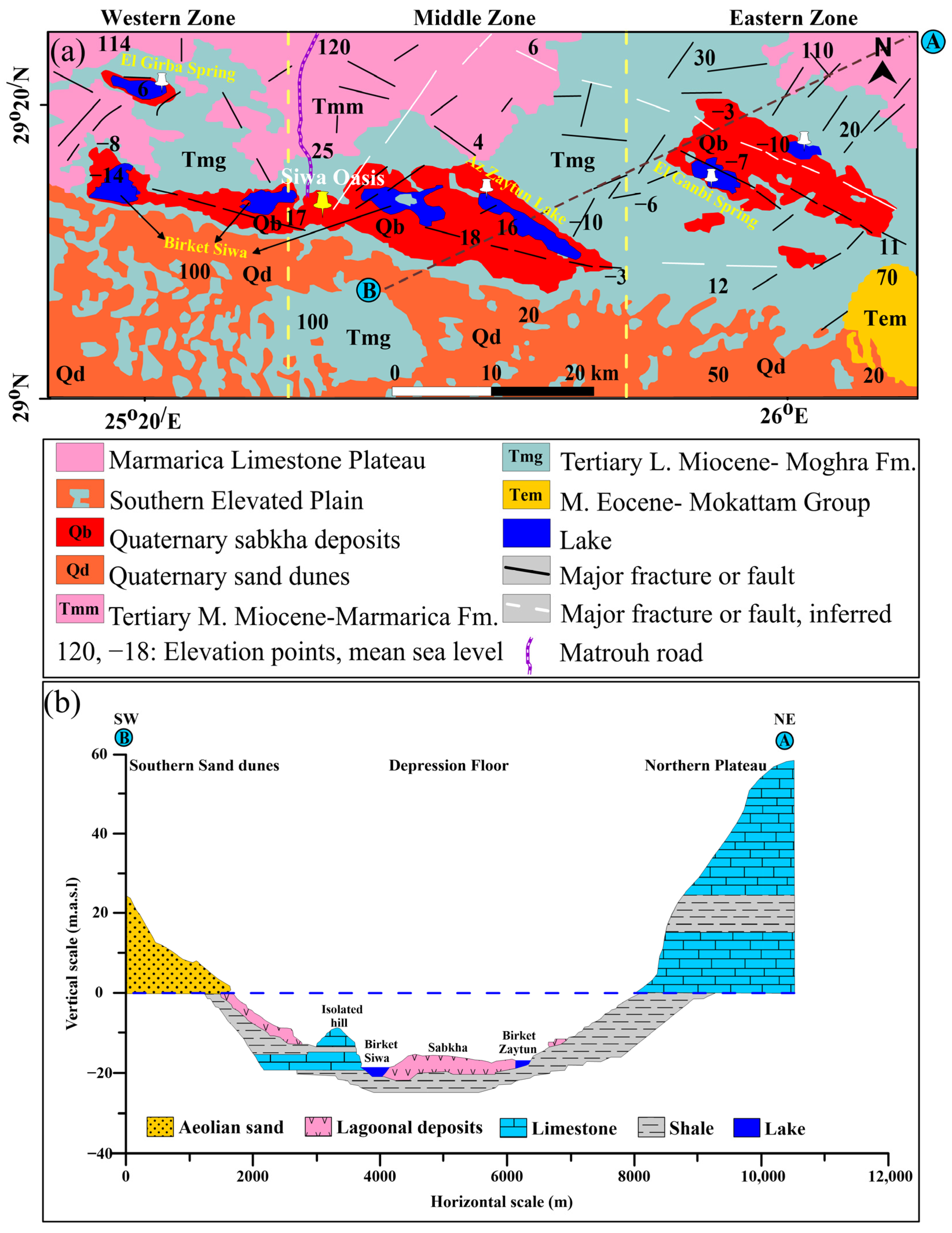
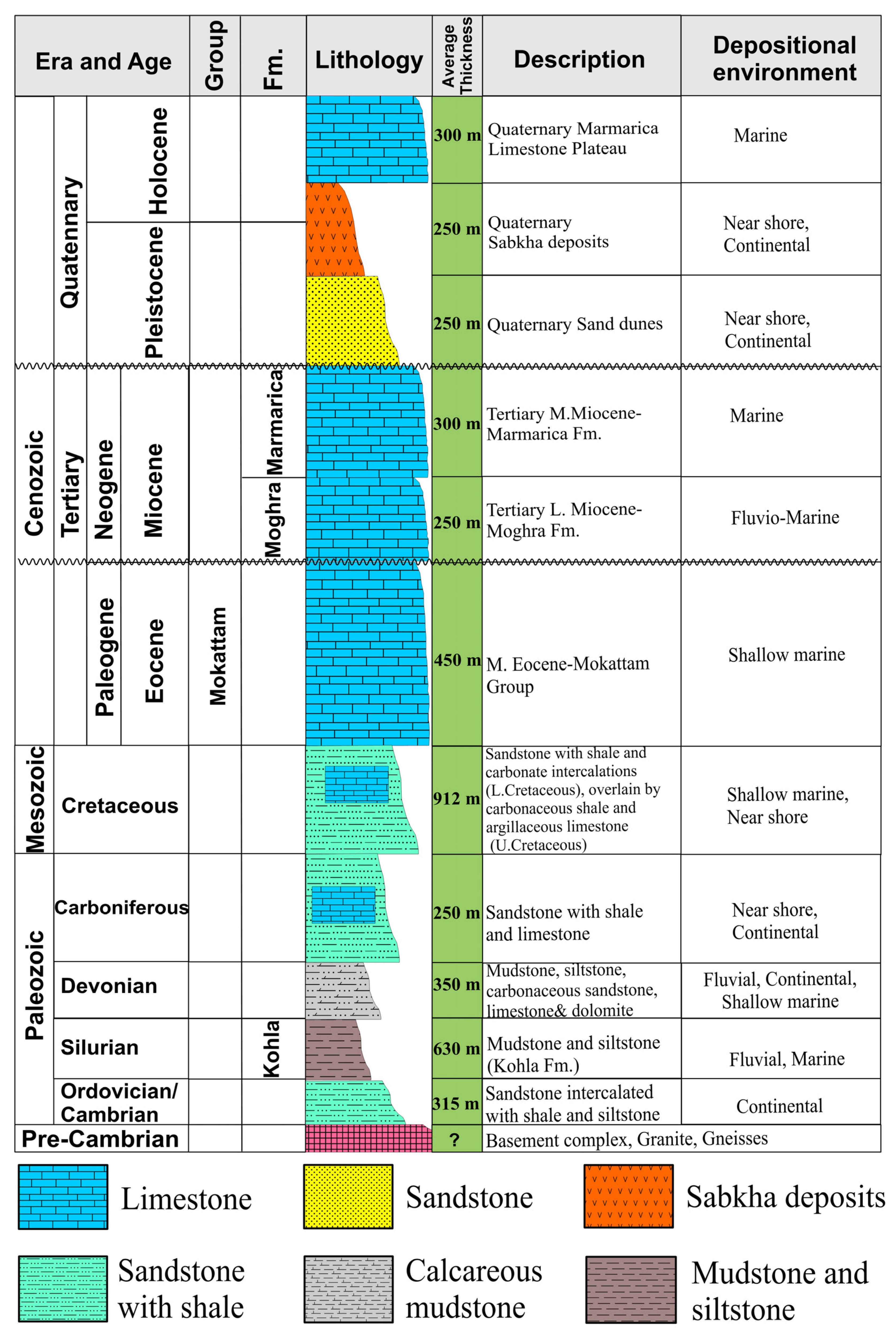
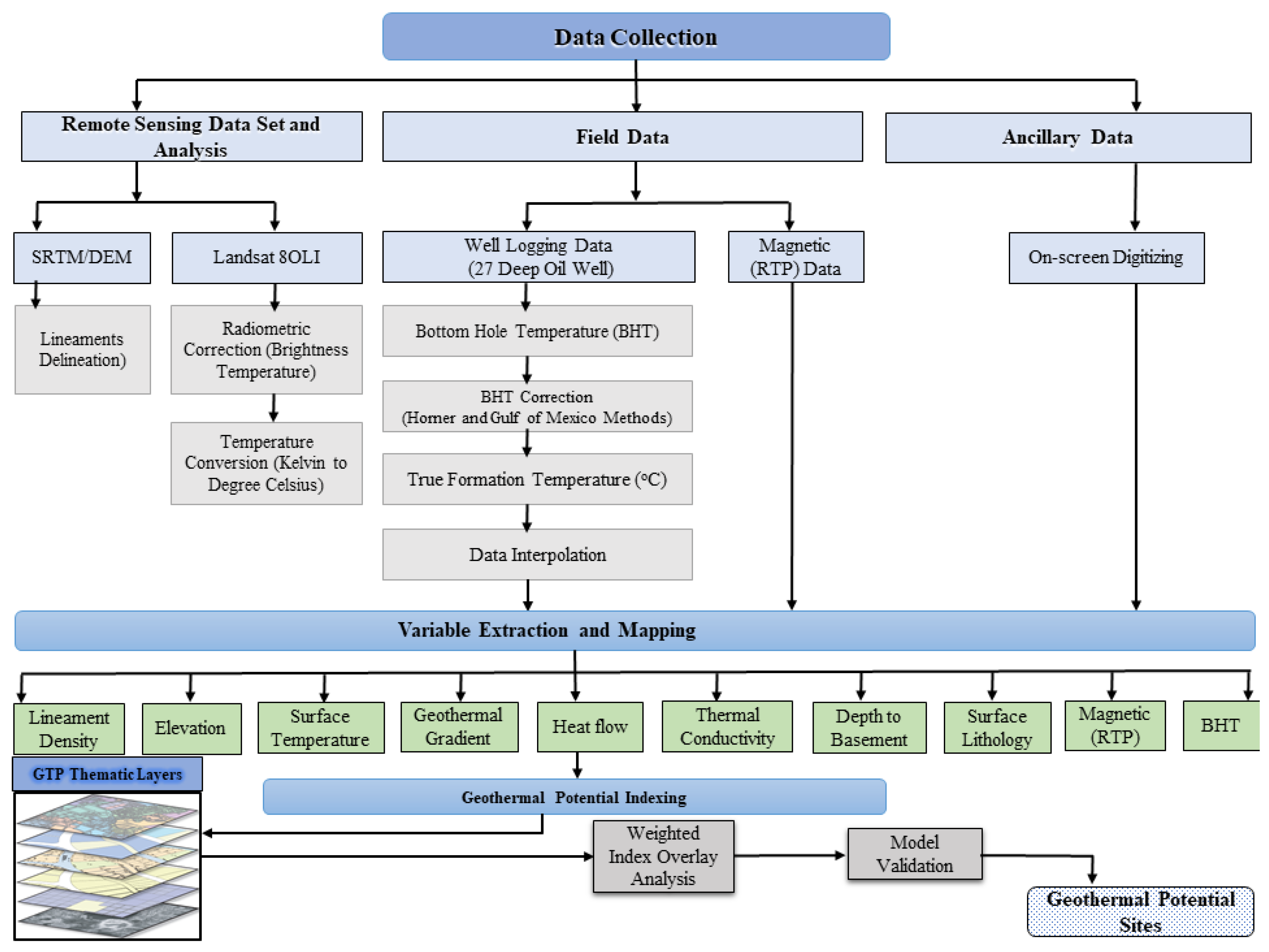
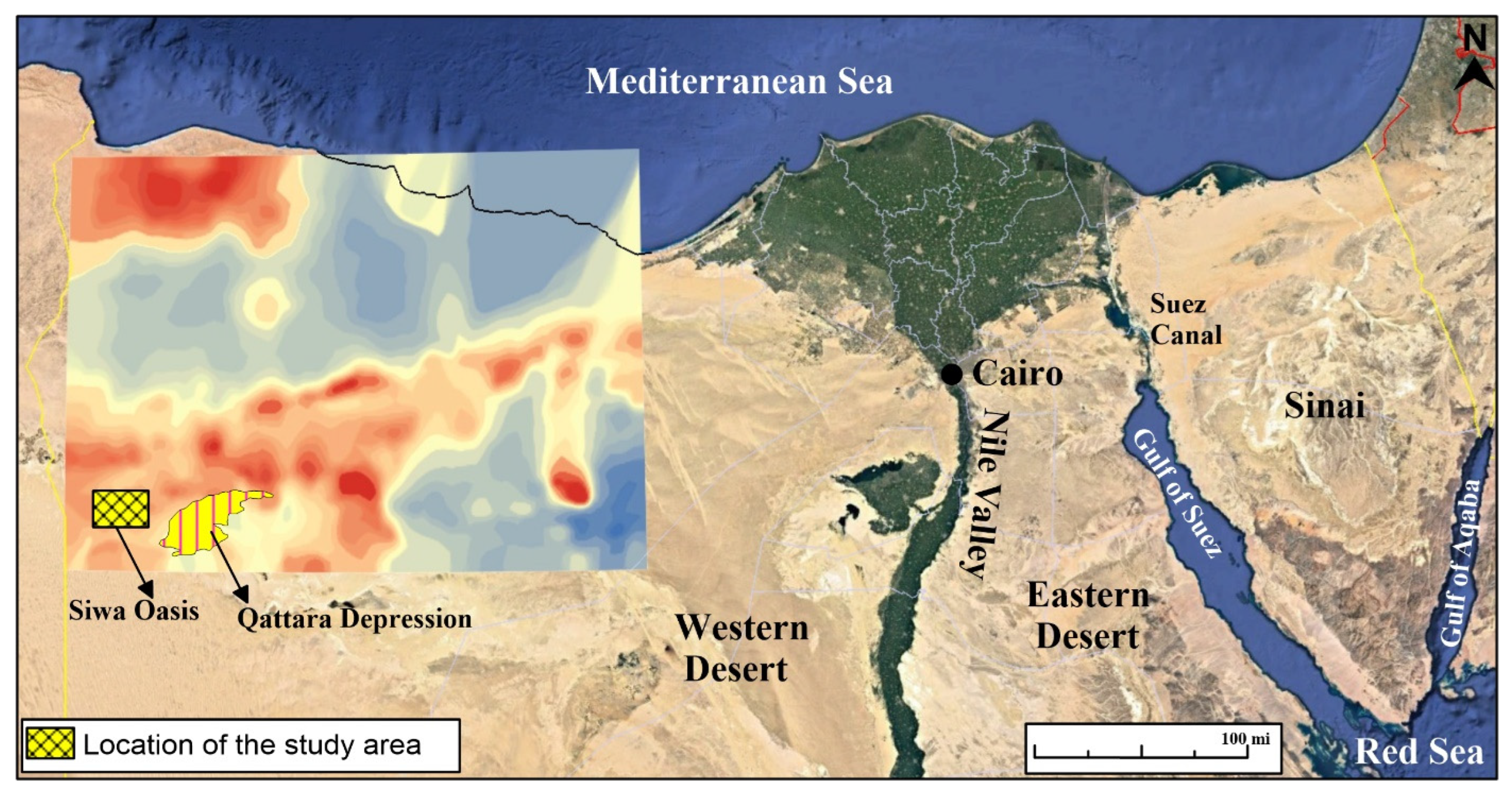
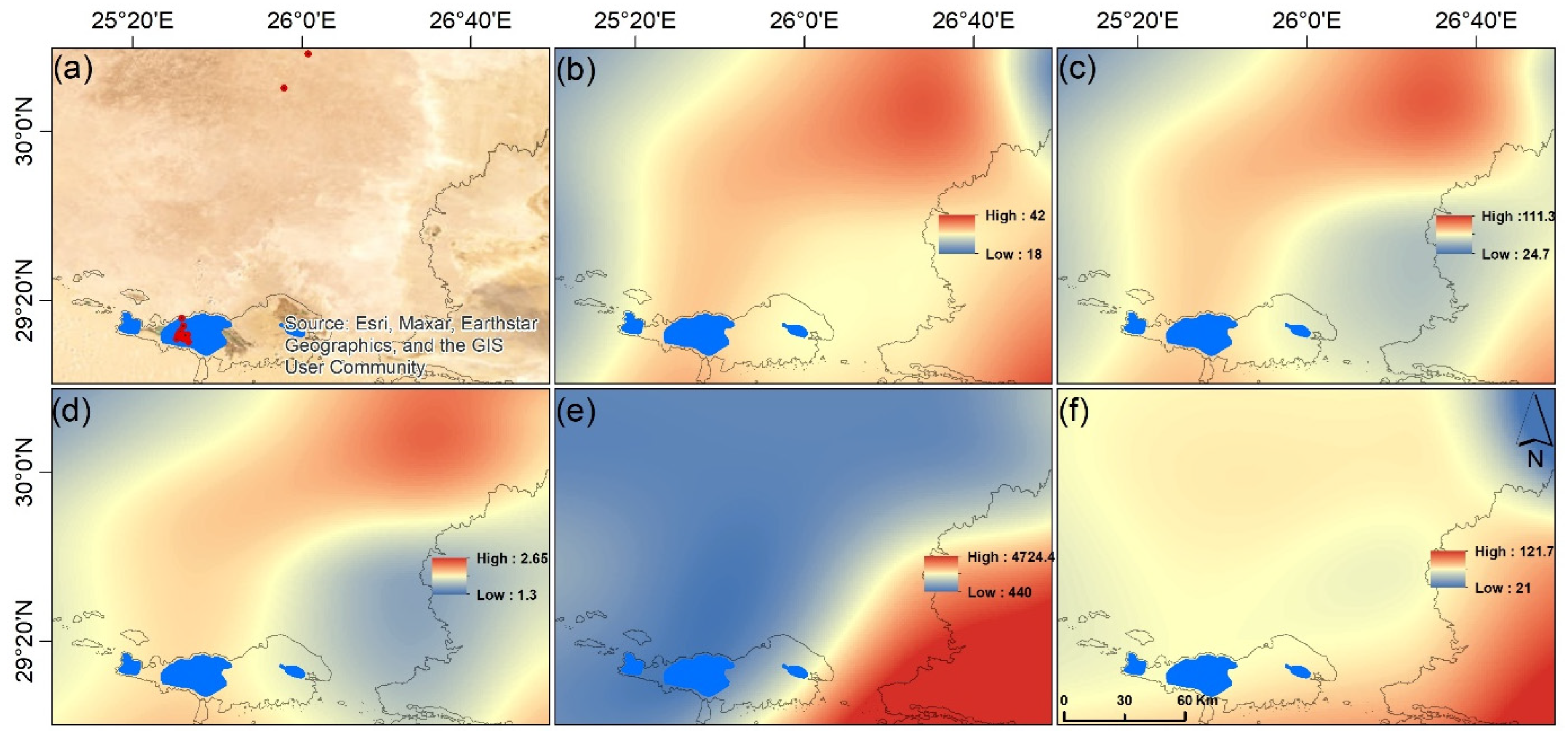
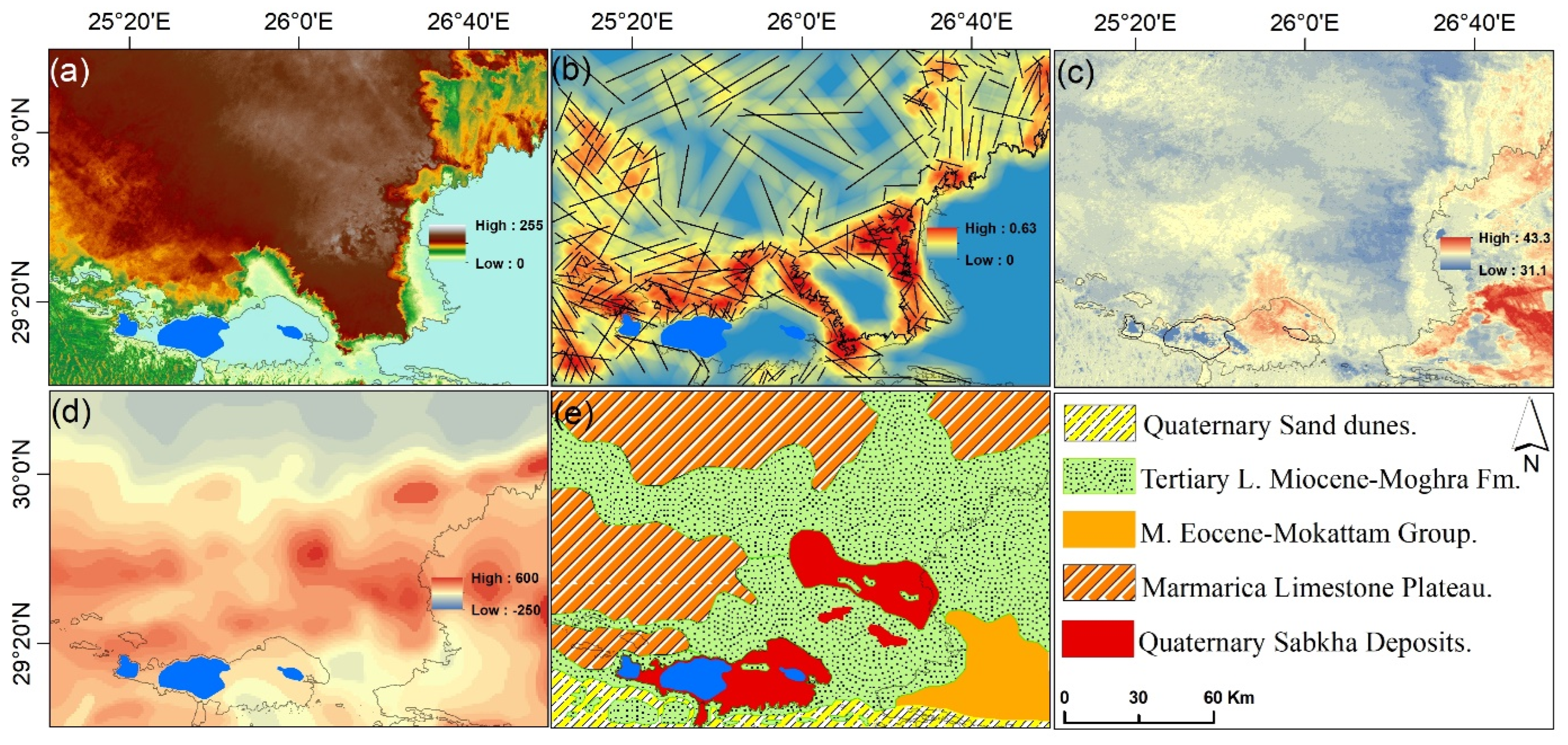


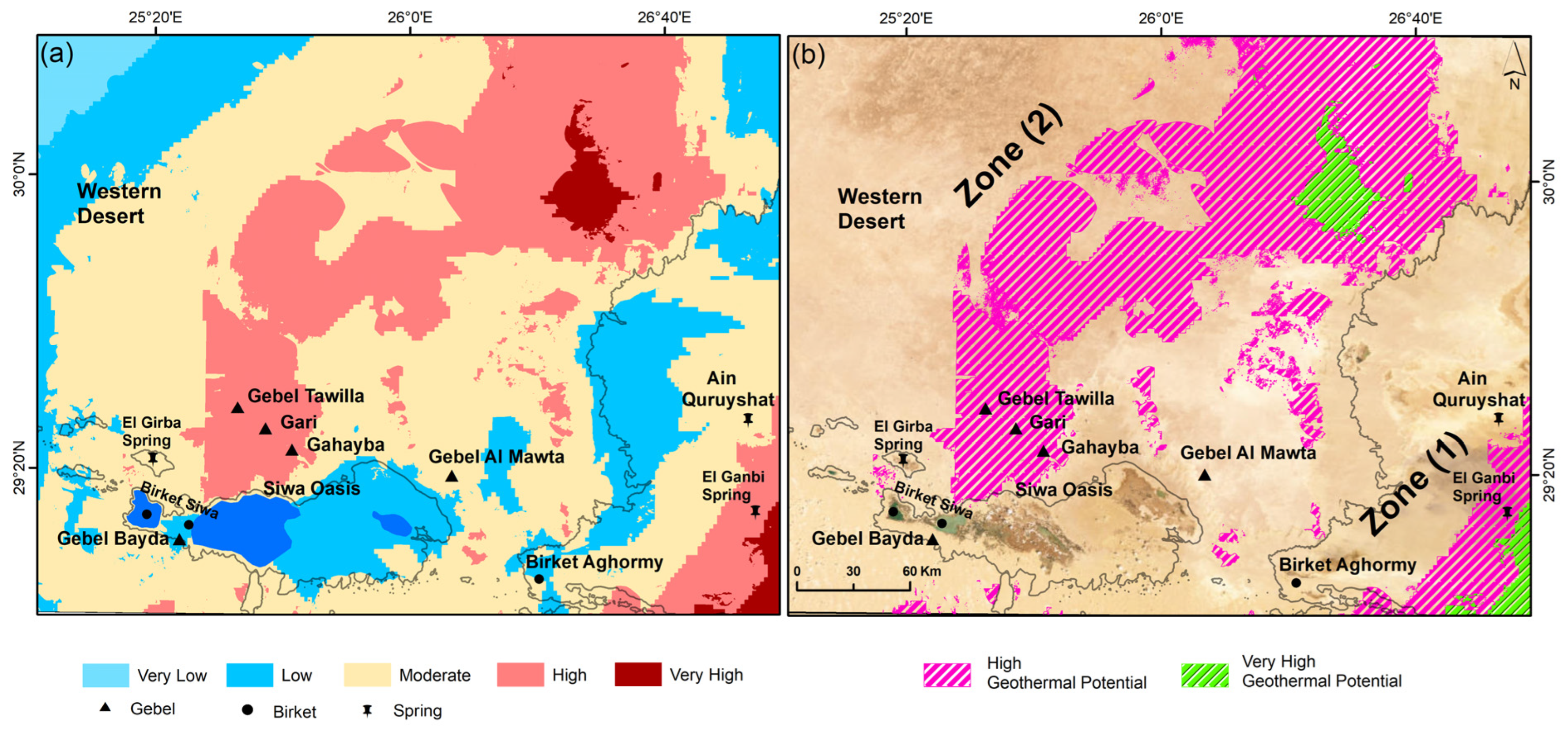
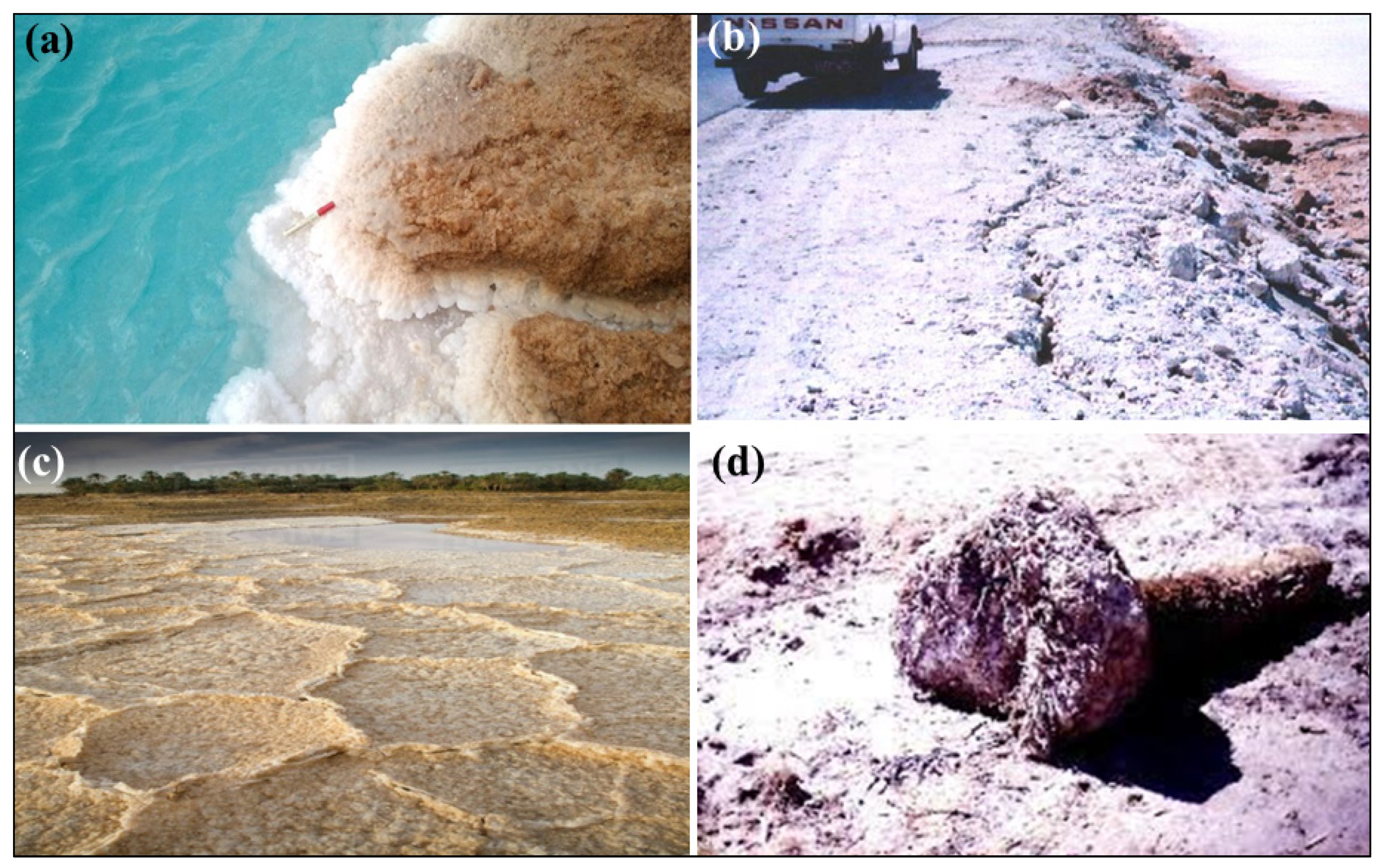
| Well Name | Latitude | Longitude | Depth (m) | Original Measured T (°C) | Gulf of Mexico | Horner | ||
|---|---|---|---|---|---|---|---|---|
| (°F) | (°C) | (°F) | (°C) | |||||
| Siwa P-1X | 30°10′11.471′′N | 25°55′50.992′′E | 4724.4 | 123.4 | 245.3 | 118.5 | 251.06 | 121.7 |
| Ain Quruyshat | 29°11′19.42′′N | 25°32′34.62′′E | 710 | 34 | 88.34 | 31.3 | 89.6 | 32 |
| Siwa Well 1 | 30°18′14.656′′N | 26°01′31.652′′E | 5029.2 | 86.2 | 182.12 | 83.4 | 186.08 | 85.6 |
| Ain Camisa | 29°11′06.09′′N | 25°31′29.33′′E | 662 | 30 | 90.14 | 32.3 | 84.2 | 29 |
| Ain Guba | 29°13′53.53′′N | 25°32′00.84′′E | 620 | 32 | 84.92 | 29.4 | 86 | 30 |
| Siwa Well 2 | 29°10′9.8′′N | 25°33′17.4′′E | 960 | 43 | 104.18 | 40.1 | 107.6 | 42 |
Disclaimer/Publisher’s Note: The statements, opinions and data contained in all publications are solely those of the individual author(s) and contributor(s) and not of MDPI and/or the editor(s). MDPI and/or the editor(s) disclaim responsibility for any injury to people or property resulting from any ideas, methods, instructions or products referred to in the content. |
© 2023 by the authors. Licensee MDPI, Basel, Switzerland. This article is an open access article distributed under the terms and conditions of the Creative Commons Attribution (CC BY) license (https://creativecommons.org/licenses/by/4.0/).
Share and Cite
Ghoneim, E.; Healey, C.; Hemida, M.; Shebl, A.; Fahil, A. Integration of Geophysical and Geospatial Techniques to Evaluate Geothermal Energy at Siwa Oasis, Western Desert, Egypt. Remote Sens. 2023, 15, 5094. https://doi.org/10.3390/rs15215094
Ghoneim E, Healey C, Hemida M, Shebl A, Fahil A. Integration of Geophysical and Geospatial Techniques to Evaluate Geothermal Energy at Siwa Oasis, Western Desert, Egypt. Remote Sensing. 2023; 15(21):5094. https://doi.org/10.3390/rs15215094
Chicago/Turabian StyleGhoneim, Eman, Colleen Healey, Mohamed Hemida, Ali Shebl, and Amr Fahil. 2023. "Integration of Geophysical and Geospatial Techniques to Evaluate Geothermal Energy at Siwa Oasis, Western Desert, Egypt" Remote Sensing 15, no. 21: 5094. https://doi.org/10.3390/rs15215094
APA StyleGhoneim, E., Healey, C., Hemida, M., Shebl, A., & Fahil, A. (2023). Integration of Geophysical and Geospatial Techniques to Evaluate Geothermal Energy at Siwa Oasis, Western Desert, Egypt. Remote Sensing, 15(21), 5094. https://doi.org/10.3390/rs15215094








